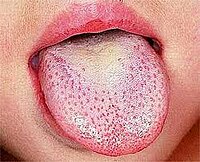
Photo from wikipedia
A 26-year-old heterosexual man described a 1-week history of dysuria and urinary frequency. He then developed progressively worsening left knee pain, swelling and restriction of movement resulting in presentation to… Click to show full abstract
A 26-year-old heterosexual man described a 1-week history of dysuria and urinary frequency. He then developed progressively worsening left knee pain, swelling and restriction of movement resulting in presentation to hospital. There was no conjunctivitis or ocular, oral or genital ulceration. There was no family history of autoimmune disease or inflammatory arthropathy. He had an elevated C-reactive protein at 113 mg/L. Mid-stream urine demonstrated sterile pyuria with negative polymerase chain reaction (PCR) for both Chlamydia trachomatis and Neisseria gonorrhoeae. Testing for human immunodeficiency virus, hepatitis B and C, and syphilis were negative, as were two sets of blood cultures. Rheumatoid factor and cycliccitrullinated peptide antibodies were also negative. The antinuclear antibody screen was weakly positive with a titre of 40 in a speckled pattern; however, an extractable nuclear antigen screen was negative. He was positive for human leucocyte antigen (HLA) B27. An aspirate of the left knee was performed and analysis of the synovial fluid revealed a white blood cell count of 6900 10/L (85% neutrophils). Gram-stain and bacterial culture were negative, as was N. gonorrhoeae PCR. The patient was commenced on intravenous ceftriaxone 2 g daily for a total of 5 days without improvement. An arthroscopic washout of the left knee was then performed. Mycoplasma genitalium PCR was added to the initial urine sample and was positive. He was given azithromycin 1 g followed by doxycycline 100 mg twice daily for 7 days, followed by another single dose of azithromycin 1 g and then 500 mg daily for a further 3 days. Anti-inflammatories were also given for suspected sexually acquired reactive arthritis (SARA). After an initial clinical response, he experienced an acute exacerbation of left knee pain and swelling, as well as recurrence of dysuria. M. genitalium PCR with macrolide resistance testing was performed on a repeat urine specimen, which demonstrated presence of macrolide resistance mutations. He was given doxycycline 100 mg twice daily for 7 days followed by moxifloxacin 400 mg daily for a further week. He experienced an excellent clinical response to treatment of urethritis and a test-of-cure performed on urine 4 weeks after completion of antimicrobial therapy was negative. His left knee monoarthritis persisted for at least 4 months after negative test of cure, requiring intra-articular corticosteroid therapy and methotrexate before complete resolution was documented. This case describes SARA secondary to a macrolideresistant M. genitalium infection. The pathophysiology and significance of SARA secondary to M. genitalium has been proposed in both animals and humans. In a small case series of patients with reactive arthritis, two had M. genitalium detected by PCR in synovial fluid specimens. One was a 25-year-old man with bilateral conjunctivitis and asymmetrical oligoarthritis. Another report described a 29-year-old HLA-B27-positive man with lower limb oligoarthritis that developed 2 weeks after PCR-proven M. genitalium urethritis. It is reasonable to request routinely testing for M. genitalium in men presenting with nongonococcal urethritis as advocated by current guidelines. The present case also highlights the significance of rising rates of macrolide resistance observed among M. genitalium infections. The prevalence of macrolide-resistant M. genitalium in Australia exceeds 50% in heterosexuals and 85% in men who have sex with men. One of the purported major drivers of the increased rates of macrolide resistance is the widespread use of single-dose azithromycin for empiric management of non-gonococcal urethreitis. M. genitalium should be considered in the differential diagnosis for reactive arthritis, particularly when no other causes are found; a heightened awareness of macrolide resistance among M. genitalium infections is also important for management.
Journal Title: Internal Medicine Journal
Year Published: 2022
Link to full text (if available)
Share on Social Media: Sign Up to like & get
recommendations!